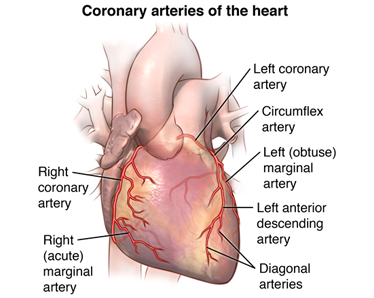What Is CAD?
This plaque is made up of fat, cholesterol, calcium and blood clotting material called fibrin.


- Narrows the arteries. The heart doesn’t get enough blood, it causes chest pain or discomfort called ANGINA
- Completely blocks the arteries, which stops the flow of blood to the heart muscle resulting in a HEART ATTACK
- Causes blood clots to develop at the site of plaque in the coronary artery leading to a HEART ATTACK.
Over time, CAD can weaken the heart muscle and contribute to:
- Heart failure: The heart fails to pump blood the way that it should.
- Arrhythmias: These are changes in the normal beating rhythm of the heart.
-
Diabetes
-
Smoking
-
High Blood pressure
-
High Blood Cholesterol
-
Overweight or obesity
-
Lack of physical activity
-
Radiation Therapy to the Chest as used in certain types of cancer
-
Hereditary (Genetic)
- Chest Pain
- Pressure or tightness in your chest, triggered by physical or emotional stress.
- Pain may also be felt in the shoulders, arms, neck, throat, jaw or back.
- Symptoms of Heart Failure
- Shortness of breath (breathlessness) with exertion
- Fatigue
- Swelling in your feet and ankles.
- Palpitations and irregular heart beats
- Heart attack : Heart attack may be the first sign of CAD. It may be accompanied by sweating, nausea or vomiting.
- Chest X-ray
- Electrocardiogram (ECG)
- Echocardiogram
- Stress test
- Coronary Angiogram: is done to view blood flow through your heart. This will reveal any blockages in the coronary arteries.
- Nuclear heart scan / MRI: These advanced tests may be needed in certain situations to determine the function of the heart and viable heart tissue.
How Is Coronary Artery Disease Treated?
Lifestyle Changes
Making lifestyle changes can help treat and limit the progression of CAD. For some people, these changes may be the only treatment needed:
-
Eat a healthy diet to prevent or reduce high blood pressure and high blood cholesterol and to maintain a healthy weight
-
Quit smoking, if you smokeExercise, as directed by your doctorLose weight, if you are overweight or obeseReduce stress
Medicines
In addition to making lifestyle changes, medicines may be needed to treat CAD. Some medicines decrease the workload on the heart and relieve symptoms of CAD. Others decrease the chance of having a heart attack or dying suddenly and prevent or delay the need for a special procedure (for example, angioplasty or bypass surgery).
Several types of medicine are commonly used to treat CAD.
- Antiplatelets ( Aspirin / Clopidogrel)
- Beta blockers ( Metoprolol)
- ACE (angiotensin-converting enzyme) inhibitors (Ramipril)
- Cholesterol-lowering medicines (Atorvastatin)
- Calcium channel blockers (Amlodepin)
- Nitroglycerin
- Long-acting nitrates
Angioplasty or bypass surgery may be used to treat CAD if:
- Medicines and lifestyle changes have not improved your symptoms.
- Your symptoms are getting worse.
- If your tests such as stress test and angiogram reveal significant blockages, putting you at a high risk for a heart attack.
Angioplasty
This procedure opens blocked or narrowed coronary arteries using a balloon. It can improve blood flow to your heart, relieve chest pain, and prevent a heart attack. During balloon angioplasty, a device called a stent is placed in the artery to keep the artery open after the procedure.Coronary artery bypass surgery
In this procedure arteries or veins from other areas in your body are used to bypass your narrowed coronary arteries. Bypass surgery can improve blood flow to your heart, relieve chest pain, and prevent a heart attack.
Some people may need to have angioplasty or bypass surgery on an emergency basis during a heart attack to limit damage to the heart.Cardiac Rehabilitation
Your doctor may prescribe cardiac rehabilitation (rehab) for angina or after bypass surgery, angioplasty, or a heart attack. Cardiac rehab, when combined with medicines and surgical treatments, can help you recover faster, feel better, and develop a healthier lifestyle.Cardiac rehab often begins in the hospital after a heart attack, heart surgery, or other heart treatment. Rehab continues in an outpatient setting after you leave the hospital.
Rehab has two parts:
- Exercise training. This helps you learn how to exercise safely, strengthen your muscles, and improve your stamina. Your exercise plan will be based on your individual ability, needs, and interests.
- Education, counseling, and training. This helps you understand your heart condition and find ways to reduce your risk of future heart problems. The cardiac rehab team will help you learn how to cope with the stress of adjusting to a new lifestyle and to deal with your fears about the future.
